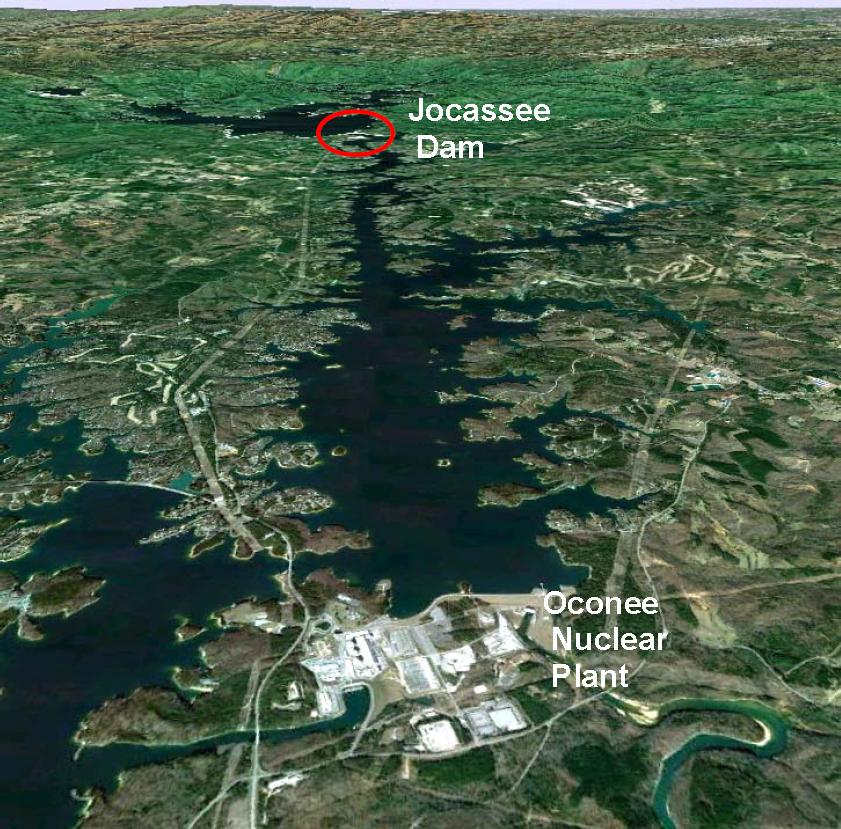Fission Stories #173
Irony is not just the opposite of wrinkly. It also applies to the results obtained from sustained efforts by the owner of the Oconee Nuclear Station in South Carolina to downplay one minor safety problem and in the process causing an even larger problem to be identified.
Oconee has three pressurized water reactors equipped with the usual array of emergency cooling systems. In event all these emergency systems and their backups are disabled, the standby shutdown facility is a last-ditch safety net. The “standby shutdown facility” houses safety equipment that can be used to cool one, two or all three reactor cores. A five-foot tall wall was built around the standby shutdown facility to allow it to protect the plant even if the site becomes flooded.
Oconee is located about 11 miles from the Jocassee Dam. If dam broke, the water it released could inundate the Oconee site.
A Missing Cover
In August 2003, workers removed a 6-inch by 10-inch cover plate in the flood wall to run temporary power cables into the standby shutdown facility.
In June 2005, the NRC’s inspectors observed that the cover plate was still removed. The bottom edge of the opening created by the plate’s removal was only 4.6 feet off the ground. The plant’s safety studies reported that flooding at the site could reach a depth of 4.71 feet. In that case, water flowing into the standby shutdown facility could disable the emergency equipment inside and leave the operators without means to prevent three reactor cores from melting down.
The NRC inspectors wrote up the missing flood barrier as a violation. On November 22, 2006, the NRC informed the owner of its determination that the impaired flood barrier involved low to moderate risk and of its characterization of the violation as white, the third most serious significance level in the NRC’s green, white, yellow, and red ranking scheme.
But the plant’s owner contested that white finding on December 20, 2006. The NRC staff listened to the company’s arguments, but affirmed its white finding on March 1, 2007. The company appealed the white finding to NRC senior management on May 3, 2007.
Worse Than a Missing Cover
During its reevaluation of the flooding issue, the NRC staff discovered that the company made a mistake when calculating the chances of the upstream Jocassee Dam failing. They had counted only 3 failures of dams identical to Jocassee in the numerator but had counted 220,080 operating years from all kinds of dams in the denominator to determine a failure rate of 1.4 x 10-5 per year. When the NRC staff corrected the calculation to be an apples-to-apples basis, the failure odds became about 10 times higher (1.92 x 10-4 per year). The NRC staff further found that the company could not retrieve the calculation that established the 4.71-foot flood level while other available analyses showed flooding levels from 10 to 16.8 feet.
The NRC staff reaffirmed the white finding on November 20, 2007.
Enter the Oconee irony. En route to losing two appeals of a white finding for inadequate flooding protection, the owner helped the NRC identify an even larger, more costly flood protection deficiency. Instead of having to merely fix a 6-inch by 10-inch opening in a 5-foot tall flood barrier, the owner succeeded in cluing the NRC into realizing the 5-foot tall flood barrier might be too short by nearly a dozen feet or more.
In other words, had the owner simply keep its mouth shut and just “bobble-headed” the white finding, it could have limited the fixes to bolting the cover plate back in place.
But no, the owner’s obstinacy turned a cheap fix into far more extensive and expensive fixes.
On August 15, 2008, the NRC staff sent a letter to the owner requiring a response under 10 CFR 50.54(f) on flooding hazard and associated flooding preventing measures. The NRC sent two subsequent requests for additional information to the owner.
On June 3, 2010, the owner committed to 15 measures to better protect Oconee from flooding hazards. Each measure cost more than bolting a 6-inch by 10-inch cover plate back in place. And collectively, these dozen-plus measures cost way, way more than silently accepting the original white finding as-is.
On June 22, 2010, the NRC issued a confirmatory action letter to the company mandating completion of the flooding fixes within a specified time.
Our Takeaway
The NRC’s inspectors discovered an opening in a flood wall protecting the last set of equipment installed at Oconee to prevent its three reactor cores from meeting down.
The NRC issued a white finding to the owner having operated the plant in this impaired condition for several years.
Oconee’s owner contested this NRC sanction—twice—on grounds that the situation was not as bad as the NRC thought.
Oconee’s owner was right—the situation was even worse than the NRC thought.
Instead of being impaired by a 6-inch by 10-inch opening in a 5-foot flood wall, the flood wall is more than 10 feet too short.
And by whining about a wee little problem, Oconee’s owner must now pay to fix a large, costly one.
As Nelson Muntz on The Simpsons says, “ha-ha.”
“Fission Stories” is a weekly feature by Dave Lochbaum. For more information on nuclear power safety, see the nuclear safety section of UCS’s website and our interactive map, the Nuclear Power Information Tracker.

